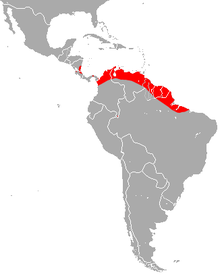Smoky gray short-eared bat
| Smoky gray short-eared bat | ||||||||||||
|---|---|---|---|---|---|---|---|---|---|---|---|---|
| Systematics | ||||||||||||
|
||||||||||||
| Scientific name of the genus | ||||||||||||
| Cyttarops | ||||||||||||
| Thomas , 1913 | ||||||||||||
| Scientific name of the species | ||||||||||||
| Cyttarops alecto | ||||||||||||
| Thomas , 1913 |
The smoky gray short-eared bat ( Cyttarops alecto ) is a bat in the family of the smooth-nosed free-tailed bat (Emballonuridae) and the only species in the genus Cyttarops . The scientific generic name is composed of the Greek words kyttaros (honeycomb) and ops (eye or face). Presumably Oldfield Thomas chose the name because of a skull depression on the forehead, which is covered by fur. The epithet alecto means "protected".
features
The species reaches a head-trunk length of 50 to 55 mm, a forearm length of 45 to 47 mm and a tail length of 20 to 25 mm. Females are generally slightly larger than males. In contrast to most other family members, there are no pocket-like structures with attached glands on either the wings or the tail skin . The long and soft fur has a black color on top, occasionally with dark gray areas on the shoulders and on the back of the body, the underside is dark gray. Cyttarops alecto has short tubular nostrils that point outwards like an upside-down V. The species also differs from other family members in the structure of the thumb bones and in different skull details.
Distribution and way of life
This bat is found in Central and South America. Its distribution area extends from Nicaragua to Colombia and continues in a wide band along the Atlantic Ocean to the mouth of the Amazon . The species resides in regions that do not exceed 500 meters above sea level.
Individual specimens or smaller groups of up to ten individuals rest under palm fronds. They hold on to the leaf veins with their feet. The animals start a 15 to 30 minute flight around the resting place around 45 minutes after sunset. Then they hunt for flying insects over more or less open terrain. When hunting, they fly about 3 to 4 meters above the ground. A lactating female with a cub has been observed in Costa Rica .
status
Although the species is rarely seen, it is listed as Least Concern by the International Union for Conservation of Nature (IUCN) due to its large distribution area .
swell
- Don E. Wilson , DeeAnn M. Reeder (Eds.): Mammal Species of the World . A taxonomic and geographic Reference . 3. Edition. 2 volumes. Johns Hopkins University Press, Baltimore MD 2005, ISBN 0-8018-8221-4 (English, Cyttarops ).
- Cyttarops alecto inthe IUCN Red List of Threatened Species 2015.2. Posted by: Lim, B., Miller, B., Reid, F., Arroyo-Cabrales, J., Cuarón, AD & de Grammont, PC, 2008. Retrieved August 21, 2015.
- Starrett, Andrew: Cyttarops alecto , Mammalian Species , No. 13 (1972): pp. 1-2
- Alfred L. Gardner (Ed.). " Cyttarops alecto ". Mammals of South America, Volume 1 . University of Chicago Press, 2008, pp. 188-189. ISBN 0-226-28240-6
- Eisenberg & Redford Cyttarops alecto , Mammals of the Neotropics, 2000, p. 129

